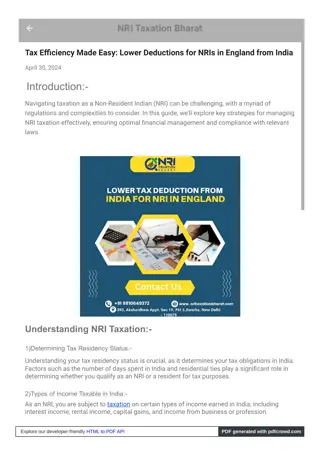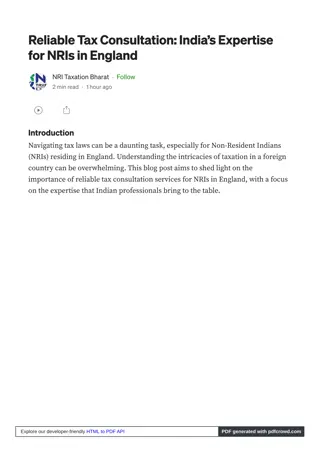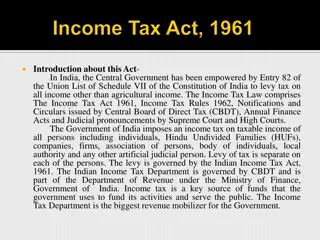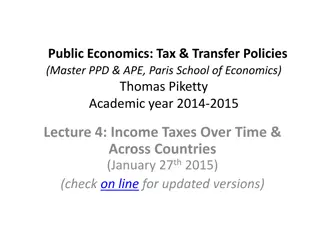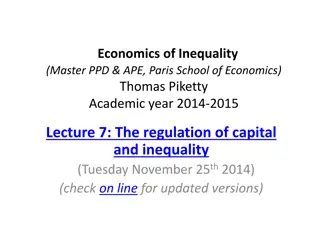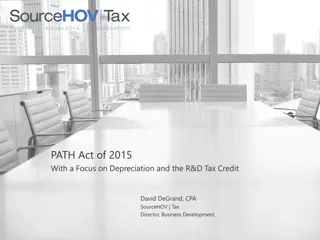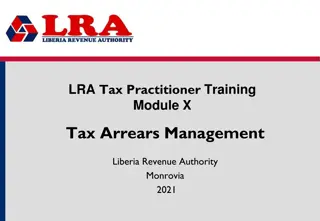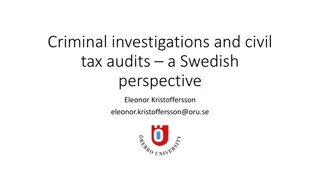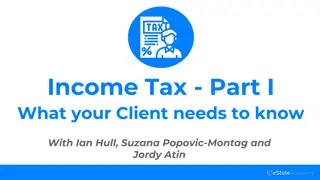Introduction to Wealth Tax Act, 1957 in India
The Wealth Tax Act, 1957 was a legislation in India that imposed a tax on the net wealth of individuals, Hindu undivided families (HUFs), and companies. The Act ceased to be applied from April 1, 2016, and was replaced with a surcharge on the super-rich. The Act defined net wealth as the difference between the total value of assets and debts on a specified valuation date. Assets subject to wealth tax included properties, motor cars not used for business, and certain precious items.
Download Presentation

Please find below an Image/Link to download the presentation.
The content on the website is provided AS IS for your information and personal use only. It may not be sold, licensed, or shared on other websites without obtaining consent from the author.If you encounter any issues during the download, it is possible that the publisher has removed the file from their server.
You are allowed to download the files provided on this website for personal or commercial use, subject to the condition that they are used lawfully. All files are the property of their respective owners.
The content on the website is provided AS IS for your information and personal use only. It may not be sold, licensed, or shared on other websites without obtaining consent from the author.
E N D
Presentation Transcript
An introduction to the wealth tax Act, 1957 The Wealth Tax Act, 1957 was an Act of the parliament of India which was levying of wealth tax on .. 1) an individual, 2) Hindu undivided family (HUF) 3) or company. The wealth tax was levied on the net wealth owned by a person on a valuation date. The Act applies to the whole of India. The application of the Act has been discontinued since 1 April 2016. The wealth tax was abolished in the Union budget (2016 - 2017) presented by Union Finance Minister Arun Jaitley on 28 February 2016. The wealth tax was replaced with an additional surcharge of 2 per cent on the super rich with a taxable income of over 1 crore annually.
Net wealth or taxable wealth Net wealth or taxable wealth Net wealth as define under sec. 2(m) of the wealth tax Act, 1957- net wealth means the amount by which the aggregate value of all assets, wherever located, belonging to the assessee on the valuation date, including assets required to be included in his net wealth as on that date under this act, is in excess of the aggregate value of all the debts owned by the assessee on the valuation date which have been incurred in relation to the said assets. It means we find net wealth as follows: Value of assets belonging to the assessee as on the valuation date + deemed wealth under sec. 4 _. Assets exempt under sec. 5 _. Debts incurred in relation to assets included in net wealth = then we found net wealth. Although taxable wealth means net wealth under the wealth tax act, 1957, and net wealth find according to valuation of assets. Therefore, it is necessary to know about the meaning of assets.
Meaning and valuation of assets Wealth tax is levied on the value of assets. The term assets is defined under Section 2(ea) of the Wealth-tax Act. Hence, wealth tax is levied only on those properties which are covered in the definition of the term assets as defined in the Wealth-tax Act. Following items are covered in the definition of the term assets . Any building or land appurtenant thereto, whether used for residential or commercial purposes or for the purpose of maintaining a guest house or otherwise. It will also include a farm house situated within 25 kilometers from local limits of any municipality or a Cantonment Board. However, following buildings or land appurtenant thereto are not included in this category : 1) A house meant exclusively for residential purposes and which is allotted by a company to an employee or an officer or a director who is in whole-time employment, having a gross annual salary of less than Rs. 10,00,000. Any house (may be residential house or used for commercial purposes) which forms part of stock-in-trade of the taxpayer. Any house occupied by the taxpayer for the purposes of any business or profession carried on by him. Any residential property which has been let-out for a minimum period of 300 days in the previous year. Any property in the nature of commercial establishments or complexes.
To be continue 2)- Motor cars (other than those used by the taxpayer in the business of running them on hire or held as stock-in-trade). 3)- Jewellery, bullion, furniture, utensils or any other article made wholly or partly of gold, silver, platinum or any other precious metal or any alloy containing one or more of such precious metals. However, this category does not include any of the above items held as stock-in-trade by the taxpayer. 4)- Yachts, boats and aircrafts (other than those used by the taxpayer for commercial purposes). 5)- Urban land, other than following : Land on which construction of a building is not permissible under any law for the time being in force; or Any land on which construction is done with the approval of the appropriate authority; or Any unused land held by the taxpayer for industrial purposes for a period of two years from the date of its acquisition by him; or Any land held by the taxpayer as stock-in-trade for a period of ten years from the date of its acquisition by him. Land classified as agricultural land in the records of the Government and which is used for agricultural purpose.
To be continue. Note- Urban land means a land situated: Within jurisdiction of municipality, notified area committee, town area committee, cantonment board and which have a population of not less than 10,000; a) Within range of following distance measured aerially from the local limits of any municipality or cantonment board: b) not being more than 2 KMs, if population of such area is more than 10,000 but not exceeding 1 lakh; I. not being more than 6 KMs , if population of such area is more than 1 lakh but not exceeding 10 lakhs; or II. not being more than 8 KMs , if population of such area is more than 10 lakhs. III. (6) - Cash in hand- (a) in case of individual and HUF- cash in hand in excess of Rs. 50000 will be treated as assets, whether it is recorded in the books of account or not. (b)- in the case of other persons- any cash not recorded in the books of account will be treated as an assets. Note- only cash in hand is treated as an asset, balance in bank account and cheque in hand will not be treated as an asset.
Net wealth to include certain assets Net wealth to include certain assets or Deemed assets or Deemed assets Generally, wealth tax is to be paid on assets owned by the assessee on the valuation date. However, in the following cases, though assets are held by other persons, yet they are to be included in the net wealth of the assessee, i.e., assets of other persons are clubbed with the wealth of the assessee - 1)- Asset transferred by an individual without adequate consideration to any of the following persons shall be included in the net wealth of such individual: Assets transferred to the spouse, not being a transfer in connection with an agreement to live apart. Assets transferred by an individual to his/her son s wife. Assets transferred to a person or an association of persons for the immediate or deferred benefit of the individual, his/her spouse or his/her son s wife.
To be continue. 2)- Assets belonging to minor child of an Individual will be included in the net wealth of such individual. However, no clubbing will be done in respect of assets belonging to a minor child suffering from any disability specified in section 80U of the Income-tax Act or a minor married daughter of the individual. Further, clubbing provisions will not apply in respect of any asset acquired by the minor out of his income arising to him by: (a) manual work done by him; or (b) activity involving application of his skill, talent or specialized knowledge and experience. Note: where the assets held by a minor child are to be included in computing the net wealth of an individual, such assets shall be included, a)- where the marriage of his parents subsists, in the net wealth of that parent whose net wealth (excluding the assets of the minor child so includible under this sub-section) is greater ; or b) - where the marriage of his parents does not subsist, in the net wealth of that parent who maintains the minor child in the previous year as defined in section 3 of the Income-tax Act, and where any such assets are once included in the net wealth of either parent, any such assets shall not be included in the net wealth of the other parent in any succeeding year unless the Assessing Officer is satisfied, after giving that parent an opportunity of being heard, that it is necessary so to do.
To be continue 3)- Assets transferred under revocable transfer will be clubbed in the net wealth of the transferor. 4)- Interest (i.e., assets) in a partnership firm or an association of persons. A partnership firm or an AOP is not liable to wealth-tax; however, value of taxable assets of the firm or AOP is to be computed in the prescribed manner and then the value of interest of each partner/member in such asset is included in the net wealth of the partner/member. However, where a minor is admitted to the benefits of partnership in a firm, the value of the interest of such minor in the firm shall be included in the net wealth of the parent of the minor.
To be continue 5)- If an individual transfers his property to his HUF without adequate consideration or treats his property as the property of his HUF, then such asset will be included in the net wealth of the transferor. Further, if the converted property becomes the subject-matter of a total or a partial partition among members of the family, the converted or transferred property or any part thereof, which is received by the spouse of the transferor, is deemed to be the asset of the transferor and is includible in his wealth. 6)- In the case of gift of money made by means of book entries, if the Assessing Officer is not satisfied that the money was actually gifted (i.e., transaction is merely a book entry and not a genuine gift), the value of such gift will be included in the net wealth of the donor. 7)- Holder of an impartible estate will be deemed to be the individual owner of all the properties comprised in the estate.
To be continue.. 8)- In case of property allotted or leased by a co-operative society to the member of the society, the member will be treated as the owner of the property, and the value of such property (i.e., building or part), shall be included in his net wealth. This rule is also applicable in case of a member of a company or association of person. In case of property acquired in part performance of a contract, i.e., in accordance with section 53A of the Transfer of Property Act, the person allowed to take or retain possession of any building or part thereof shall be deemed to be the owner. Accordingly, the value of such building or part shall be included while computing the net wealth of such person. 9)- In the case of property acquired as per section 269UA(f) of the Income-tax Act, 1961, it shall be included in the net wealth of a person who acquires any rights in or with respect to such building excluding any rights by way of a lease from month to month or for a period not exceeding one year.
Exempted Assets from wealth Exempted Assets from wealth- -tax tax Following assets are exempt from wealth-tax, i.e., they are exempt assets: One house or part of a house or a plot of land (not exceeding 500 Sq. Mtrs.) in case of Individual or HUF. 1) The interest of a person in the coparcenary property of any HUF of which he is a member. 2) Any property held by the taxpayer under trust or other legal obligation for any public purpose of a charitable or religious nature in India. This exemption is not applicable to business assets of charitable/religious trust except when business is incidental to the attainment of the objectives of the trust or, as the case may be, institution, and separate books of account are maintained by such trust or institution in respect of such business or the business is carried on by an institution, fund or trust referred to in clause (23B) or (23C) of section 10 of the Income-tax Act. Any one building in the occupation of former Ruler, i.e., used for the residence by a former ruler. 3) Jewellery in possession of a former ruler of a princely State, not being his personal property which has been recognised by the Central Government as a heirloom before 1-4-1957 or by the CBDT after 1-4-1957. 4)
To be continue 5)- Certain assets belonging to a person of Indian origin or an Indian citizen who was residing abroad and now returning with an intention of permanently residing in India is exempt subject to following conditions: This exemption is available only to a person of Indian origin or a citizen of A person will be said to be of Indian origin if he or any of his parents or grandparents were born in un-divided India. Such person was residing in foreign country. Exemption is available at the time he returns to India, i.e., he is an Indian repatriate. Exemption is available for a period 7 years (starting from the year in which he returns to India). The above discussed exemption is available in respect of following assets: (a)- Money brought into India at the time of his return to India. (b)- Value of assets brought into India at the time of his return to India. (c) -Money standing to the credit of such person in a Non-resident (External) Account in any bank in India on the date of his return to India. (d)- Assets acquired by him out of money referred to in (1) and (3) above within a period of one year prior to the date of his return and any time thereafter.
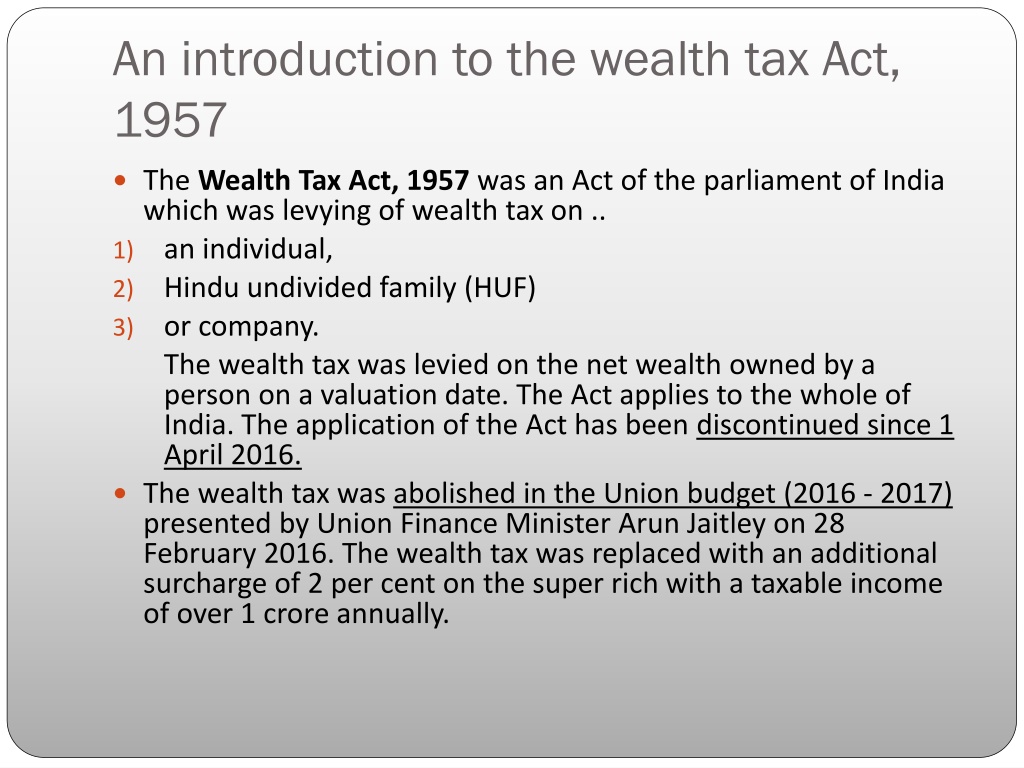





![Town of [Town Name] Real Estate Tax Rates and FY 2024 Budget Summary](/thumb/62211/town-of-town-name-real-estate-tax-rates-and-fy-2024-budget-summary.jpg)
